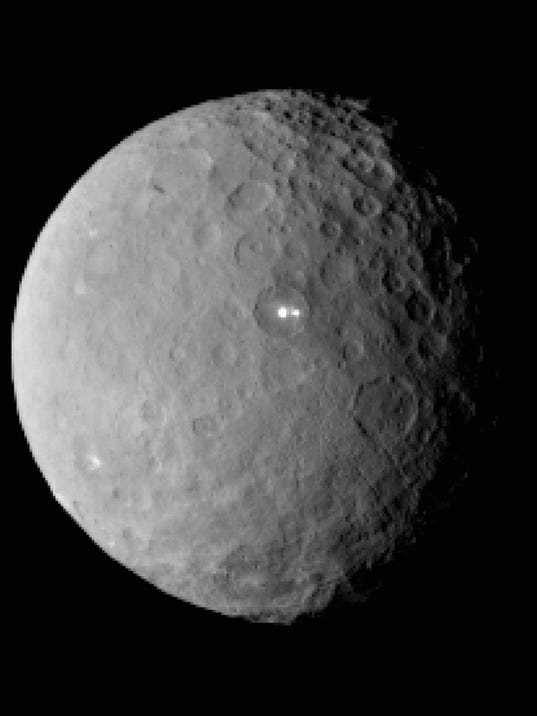Now we find out if it's aliens

The spaceship, trailing a beam of blue-green vapor behind it, looks like something out of Star Wars.
Its destination is also pure Hollywood: a pockmarked world with a frozen subterranean sea and perhaps a few geysers.
But this is no movie. The ship is NASA's Dawn spacecraft, which has scudded smoothly through the solar system for 7-1/2 years on its enormous wing-like solar panels. On Friday at roughly 7:20 a.m. ET, it will slip into orbit around a mini-planet named Ceres, which lies in the asteroid belt between Mars and Jupiter.
Dawn's job is to tell all about Ceres, which was discovered more than 200 years ago but has let slip very little about itself. Does it have polar ice caps? Does it have a liquid ocean? And could it have once harbored – or could it still harbor -- life?
"We've never even sent a spacecraft there," says Marc Rayman, Dawn's chief engineer and mission director. "This is a first reconnaissance of an entirely new world."
The planet has been like "your secretive neighbor. Ceres would tell us nothing," says Dawn principal investigator Christopher Russell of the University of California, Los Angeles. "Everything we're seeing was unexpected."
Among the most unexpected sights are the two astonishingly bright spots nestled in a crater on Ceres's surface. Photographed by Dawn's camera Feb. 19, the dots have the experts buzzing with speculation. Maybe a direct hit from an asteroid -- a space rock – excavated some buried ice. Maybe the bright spots are a sheen of minerals deposited by gushing geysers.
The spots "are unique in the solar system," Carol Raymond, deputy principal investigator of the Dawn mission said at a NASA briefing Monday. "The mystery will be solved, but it's really got us at the edge of our seats."
Looks they are just starting the mapping now, I still say aliens
NASA's Dawn probe has reached its first science orbit at Ceres, marking the start of the spacecraft's serious scrutiny of the mysterious dwarf planet.
Dawn arrived at the science orbit on Thursday (April 23), spiraling down to an altitude of 8,400 miles (13,500 kilometers) above Ceres, NASA officials said. The probe achieved this milestone on schedule, but not without a bit of drama.
"Following a delay in communicating a command sequence, the spacecraft briefly entered into safe mode and awaited further instructions, which were sent by mission controllers," NASA officials wrote in a mission update on Friday (April 24). "As of early Friday, April 24, the spacecraft returned to normal operating mode and the mission team continues to prepare for science data collection."
New pics

In this closest-yet view, the brightest spots within a crater in the northern hemisphere are revealed to be composed of many smaller spots. However, their exact nature remains unknown.
"Dawn scientists can now conclude that the intense brightness of these spots is due to the reflection of sunlight by highly reflective material on the surface, possibly ice," said Christopher Russell, principal investigator for the Dawn mission from the University of California, Los Angeles.
Most Users Ever Online: 698
Currently Online:
40 Guest(s)
Currently Browsing this Page:
1 Guest(s)
Top Posters:
easytapper: 2149
DangerDuke: 2030
groinkick: 1667
PorkChopsMmm: 1515
Gravel Road: 1455
Newest Members:
Forum Stats:
Groups: 1
Forums: 12
Topics: 11482
Posts: 58640
Member Stats:
Guest Posters: 2
Members: 19842
Moderators: 0
Admins: 1
Administrators: K

 Log In
Log In Home
Home
 Offline
Offline









